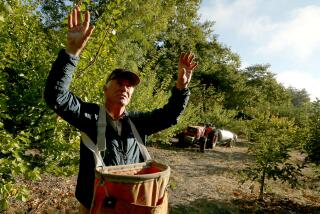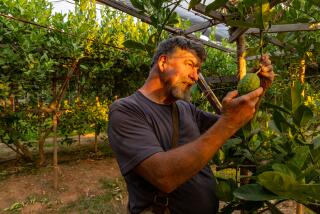Surprise! A juicy bonanza of stone fruits
THE January freeze that had citrus lovers on their knees begging for mercy now has stone fruit fans on their feet applauding. This year’s crop of peaches, plums and nectarines looks to be among the most delicious in several years.
Whether you prefer spicy cobblers and pies, creamy ice creams or just juice-dripping fruit eaten over the sink, this is going to be a summer to remember.
A good part of the credit goes to the weather last winter. Fruit trees need a certain amount of cold weather to go dormant and build up their stores of energy for the coming season.
Normally in California we’re right on the border climatically. But last winter was a bonanza in terms of winter chill. As a result, this summer’s harvests of peaches and nectarines are projected to be bigger than last year. And most important to consumers, the fruit is sweeter and better flavored.
“I think the stuff is eating really well,” says popular Santa Monica Farmers Market stone fruit grower Fitz Kelly, whose peach and nectarine orchards are located smack in the middle of the stone-fruit belt south of Fresno.
“The quality and flavor is very, very good. I regard 2004 as the landmark year for really good eating and this will be pretty close if not just as good.”
Even the early varieties — many of which, frankly, are more appreciated for their timing than their flavor — are showing very well.
“The early varieties are always a little marginal, but because of chilling, even they have got really good taste on them,” says Gary Van Sickle, research director for the California Tree Fruit Agreement, the marketing group for the state’s peach, plum and nectarine growers. “Now we’re entering into the mid-season with even sweeter fruit.”
Last spring’s weather was just about perfect as well — warm and dry with hardly a storm or heat spike to disrupt the ripening process.
The result has been measurable. Field tests of the fruit show higher sugar levels than in recent years. “Even just a half a percent more sugar can mean quite a bit in terms of flavor,” says Van Sickle.
Spring 2006 was extremely wet, hindering last year’s stone fruit harvest both in quality and quantity. And although this summer’s harvest will be bigger than last year’s, it will still fall well short of a bumper crop.
Harvests are up
CALIFORNIA’S 2007 fresh peach harvest is projected to be up about 5% from last year, or roughly 400 million pounds. That is well short of the record 450-million-pound harvest in 2003. Nectarines will be up about 10%, and plums, which flower a little later and ran into more problematic weather, will be about the same as last year.And if it seems that summer fruit started showing up earlier this year than last, that’s true too. Thanks to that warm spring and early summer, the harvest is as much as three weeks ahead. In numbers that means more than six times as many plums, three times as many peaches and more than twice as many nectarines have been harvested already.
There certainly should be no shortage of fruit for your Fourth of July feasts. One easy thing to do with it is to make a cobbler: Simply stir together one-half cup of flour and one-fourth cup of sugar, slice one-fourth cup of butter into 1-tablespoon pieces and cut that into the flour and sugar until you have a crumbly mixture.
Slice the fruit into a baking dish and sweeten it slightly. You can add warm spices such as cinnamon, cloves and nutmeg to either the fruit or the topping. Scatter the crumb mixture over the top and bake at 350 degrees until the topping is crisp and brown and the fruit is juicy and fragrant.
As a result of the big early harvest, prices are lower, though this has been partially offset by the lack of fruit coming out of South Carolina and Georgia after their disastrous spring freezes, when South Carolina lost about 90% of its peach crop and Georgia lost more than half.
To put that in perspective, though, those two states combined account for only about 10% of the peaches grown in the United States (California grows about 75%, as well as almost all of the nectarines and plums).
More important for fruit lovers, the big-flavored mid-season varieties will be coming to market sooner. In fact, growers have already started harvesting old favorites: Santa Rosa plums, the deep, wine-flavored variety developed more than 100 years ago by Luther Burbank; and rich, tangy Flavorcrest peaches.
This stone fruit season is coming hard on the heels of the recently completed California cherry harvest, which was a whopping 244% bigger than last year (admittedly, a washout because of the weather).
Still, this is the largest cherry haul ever in the state, more than 20% bigger than the previous record.
And speaking of great harvests: This year’s crop of Blenheim apricots is starting to show up in the markets. Most varieties of apricots you’ll find locally have been bred for canning or drying, and make eating fresh indifferent — at best.
Not so the venerable Blenheim (there are trees around the Ojai area that are more than 100 years old). Bite into one of these and you’ll remember what a real apricot tastes like. They’re lusciously rich in texture, sweet as honey and have a complex perfume.
James Birch of Flora Bella Farm in the Sierra foothills already has his Blenheims in the farmers market, and San Luis Obispo area apricot grower Mike Cirone says his Blenheims may be ready as early as today.
Even better, Cirone says his crop will probably last through July. “I’m excited,” he says. “I think this is going to be a really good year. The fruit size is larger than I’ve seen in many, many years and it’s a big crop on top of that.”
And you can almost hear him salivating as he says it.
russ.parsons@latimes.com
More to Read
Eat your way across L.A.
Get our weekly Tasting Notes newsletter for reviews, news and more.
You may occasionally receive promotional content from the Los Angeles Times.







